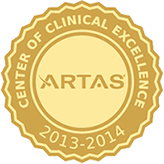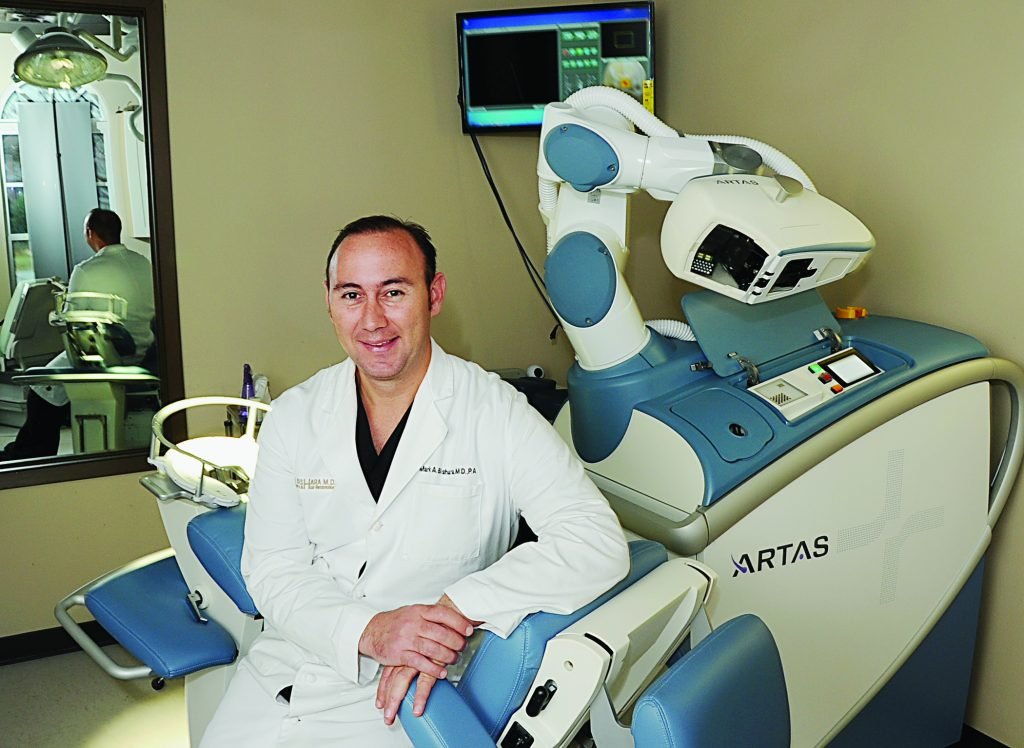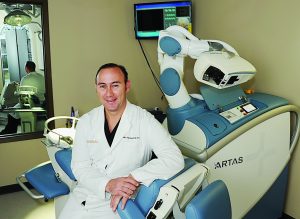Recently, Restoration Robotics launched ARTAS Hair Studio. This state of the art product allows the patient and surgeon plan and produce a simulation of a possible outcome. Although this product has some limitations to the realistic look of the transplanted hair, it does allow for a formal interaction between the surgeon and the patient that spawns more thought into the over- all operative goal and leads to increased numbers of hairs being transplanted.
The most common cause of dissatisfaction of hair transplant patients in my practice and in patients that come to me from other practices is that they didn’t get the thickness that they wanted. The ARTAS Hair Studio allows the patient to “Test Drive” their appearance and modify the operative plan under the guidance of the surgeon. It becomes the surgeon’s ethical and responsible role to provide guidance on safe and age appropriate hairline design, donor capacity, and realistic expectations on social and physiologic downtime. The ARTAS Hair Studio becomes paramount providing a sneak preview to esthetic results that vary with amount of hair.
Put together with a well informed consult discussing preventative hairless measures backed by randomized double-blinded placebo controlled trials, the ARTAS Hair Studio is quickly becoming the standard of care in hair restoration planning and patient education.
ARTAS Hair Studio also integrates directly with the robot and becomes the operative plan for the patient ensuring that the patient is receiving exactly what he is intending to recieve.
For a consultation please call 817-473-2120 or email appointments@markbisharamd.com. Skype and other internet-based consultations are available.
Mark A Bishara M.D., P.A. and Paragon Hair Clinics care for patients world-wide.
Dr. Mak A Bishara, M.D. P.A. performs robotic follicular unit graft selection for residents living around Mansfield, Southlake, Dallas, Arlington, Fort Worth, and surrounding the DFW area in North Texas.
Posts
ARTAS System vs. Neograft?
When you look at the chart below, keep in mind that a great result depends largely upon the surgeon, his training, and the skilled people who support his surgical efforts. The ARTAS® robotic system is an invaluable, timesaving tool. The computer system provides your surgeon with 3-D images of your scalp. The images guide the staff to the best areas for harvesting hair follicles. Using the ARTAS® system provides your surgeon the time to precisely create your new, natural hairline.
Neograft is a device that uses a sharp punch to isolate grafts and a suction mechanism to extract them from the scalp. Both the sharp punch and suction are felt by many doctors to cause more injury to the follicles than the blunt dissection technique (used by the ARTAS robotic system for FUE). In addition, the Neograft is a hand-held device that, unlike the ARTAS, is not an image-guided robotic system and, therefore, lacks the precision of the latter technique.
This Information is brought to you courtesy of Dr. Mark Bishara and The Paragon Plastic Surgery and Med Spa in Mansfield and Southlake, TX
Please also visit our Facebook page at Paragon Plastic Surgery and Med Spa

A recent survey conducted by the International Society of Hair Restoration Surgery (ISHRS) showed that men and women around the world are seeking to correct hair loss while they’re younger rather than putting it off until later in life.
Since the ISHRS starting tracking data on hair restoration in 2004, the extrapolated worldwide volume of surgical hair restoration procedures performed from 2004 to 2012 increased 85 percent. What explains this tremendous increase in people seeking help for hair loss, even during tough economic times? We believe the unprecedented growth and increased popularity in hair restoration over the past decade can be directly attributed to the continual refinements and advances in this type of surgery – together with proven medical therapies – that produce natural-looking, permanent results.
Other key findings of the survey include:
- The number of women undergoing hair restoration surgery worldwide increased 20 percent from 2004 to 2012
- Patients aged 30 to 49 sought treatment for hair loss more than any other age group
- In 2012, ISHRS members chose John Mayer and Sofia Vergara as the celebrities with the best hair
The ARTAS System is a 21st-century technological innovation that was introduced into the hair treatment field in 2011 to treat male pattern baldness, or androgenetic alopecia. The system is sophisticated, utilizing computer assistance to harvest hair follicles during the actual process of hair replacement. ARTAS incorporates a number of elements in its operation, including an image-guided robotic arm and special imaging technologies that coordinate together for the purpose of implementing the “follicular unit extraction (FUE)” technique upon the recipient of the system.
In our practice, we offer patients some of the latest techniques in hair restoration surgery and proven medical treatments that can help men and women permanently restore thinning hair. If you are interested in hair restoration treatments, including ARTAS robotic hair transplants, and the latest treatment options, we would be happy to speak with you or invite you for a consult at our office. Please call our office at (817) 473-2120, visit our website at www.MarkBisharaMD.com, or click on the link below.
Get our Free Guide on Robotic Hair Restoration


The ARTAS System is a 21st-century technological innovation that was introduced into the hair treatment field in 2011 to treat male pattern baldness, or androgenetic alopecia. The system is sophisticated, utilizing computer assistance to harvest hair follicles during the actual process of hair replacement. ARTAS incorporates a number of elements in its operation, including an image-guided robotic arm and special imaging technologies that co-ordinate together for the purpose of implementing the “follicular unit extraction (FUE)” technique upon the recipient of the system.
Follicular Unit Extraction
FUE is a minimally invasive technique used in hair restoration procedures to extract individual follicular units from the scalp in preparation for transplantation. Hair restoration or transplantation is used to treat hair loss, a condition that affects 50 million men and 30 million women in the United States. The system, which was developed by Restoration Robotics, features an image-guided robotic arm, small dissection punches and an interactive computer interface.
Benefits
Overall, the ARTAS System enables Dr. Bishara to harvest follicles using FUE more rapidly and with significantly lower transection rates than with traditional methods. Transection rates using ARTAS are reported at 8%, as compared with 20-30% with manual FUE. The ARTAS procedure can be done in half the surgery time compared to manual FUE. A peer reviewed manuscript by showed yield rates over 95%. The system harvests follicular units in a random fashion so that there is no scaring. Patients receiving the ARTAS procedure can return to normal activities in one to two days, compared to weeks or months for strip harvesting procedures.





